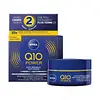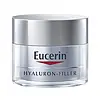What's inside
What's inside
 Key Ingredients
Key Ingredients

 Benefits
Benefits

 Concerns
Concerns

 Ingredients Side-by-side
Ingredients Side-by-side

Water
Skin ConditioningGlycerin
HumectantEthylhexyl Cocoate
EmollientMethylpropanediol
SolventCetyl Alcohol
EmollientHydrogenated Coco-Glycerides
EmollientStearyl Alcohol
EmollientButylene Glycol
HumectantCaprylic/Capric Triglyceride
MaskingButyrospermum Parkii Butter
Skin ConditioningGlyceryl Stearate Citrate
EmollientMacadamia Ternifolia Seed Oil
EmollientUbiquinone
AntioxidantCreatine
Skin Conditioning1-Methylhydantoin-2-Imide
Skin ConditioningPanthenol
Skin ConditioningLanolin Alcohol
EmollientTridecyl Stearate
EmollientTridecyl Trimellitate
EmollientDipentaerythrityl Hexacaprylate/Hexacaprate
EmulsifyingSodium Carbomer
Emulsion StabilisingEthylhexylglycerin
Skin ConditioningPhenoxyethanol
PreservativeTrisodium EDTA
Limonene
PerfumingLinalool
PerfumingBenzyl Alcohol
PerfumingCitronellol
PerfumingGeraniol
PerfumingAlpha-Isomethyl Ionone
PerfumingBenzyl Salicylate
PerfumingHexyl Cinnamal
PerfumingParfum
MaskingWater, Glycerin, Ethylhexyl Cocoate, Methylpropanediol, Cetyl Alcohol, Hydrogenated Coco-Glycerides, Stearyl Alcohol, Butylene Glycol, Caprylic/Capric Triglyceride, Butyrospermum Parkii Butter, Glyceryl Stearate Citrate, Macadamia Ternifolia Seed Oil, Ubiquinone, Creatine, 1-Methylhydantoin-2-Imide, Panthenol, Lanolin Alcohol, Tridecyl Stearate, Tridecyl Trimellitate, Dipentaerythrityl Hexacaprylate/Hexacaprate, Sodium Carbomer, Ethylhexylglycerin, Phenoxyethanol, Trisodium EDTA, Limonene, Linalool, Benzyl Alcohol, Citronellol, Geraniol, Alpha-Isomethyl Ionone, Benzyl Salicylate, Hexyl Cinnamal, Parfum
Water
Skin ConditioningGlycerin
HumectantButyrospermum Parkii Butter
Skin ConditioningIsopropyl Palmitate
EmollientPanthenol
Skin ConditioningCaprylic/Capric Triglyceride
MaskingHydrogenated Coco-Glycerides
EmollientOctyldodecanol
EmollientButylene Glycol
HumectantGlyceryl Stearate Citrate
EmollientStearyl Alcohol
EmollientCetyl Alcohol
EmollientGlycine Soja Germ Extract
EmollientSodium Hyaluronate
HumectantTocopherol
AntioxidantMethyl Methacrylate Crosspolymer
Acrylates/C10-30 Alkyl Acrylate Crosspolymer
Emulsion StabilisingDimethicone
EmollientCarbomer
Emulsion StabilisingCaprylyl Glycol
EmollientTrisodium EDTA
1,2-Hexanediol
Skin ConditioningPhenoxyethanol
PreservativeParfum
MaskingWater, Glycerin, Butyrospermum Parkii Butter, Isopropyl Palmitate, Panthenol, Caprylic/Capric Triglyceride, Hydrogenated Coco-Glycerides, Octyldodecanol, Butylene Glycol, Glyceryl Stearate Citrate, Stearyl Alcohol, Cetyl Alcohol, Glycine Soja Germ Extract, Sodium Hyaluronate, Tocopherol, Methyl Methacrylate Crosspolymer, Acrylates/C10-30 Alkyl Acrylate Crosspolymer, Dimethicone, Carbomer, Caprylyl Glycol, Trisodium EDTA, 1,2-Hexanediol, Phenoxyethanol, Parfum
 Reviews
Reviews

Ingredients Explained
These ingredients are found in both products.
Ingredients higher up in an ingredient list are typically present in a larger amount.
Butylene Glycol (or BG) is used within cosmetic products for a few different reasons:
Overall, Butylene Glycol is a safe and well-rounded ingredient that works well with other ingredients.
Though this ingredient works well with most skin types, some people with sensitive skin may experience a reaction such as allergic rashes, closed comedones, or itchiness.
Learn more about Butylene GlycolThis ingredient is also known as shea butter. It is an effective skin hydrator and emollient.
Emollients help soothe and soften your skin. It does this by creating a protective film on your skin. This barrier helps trap moisture and keeps your skin hydrated. Emollients may be effective at treating dry or itchy skin.
Shea butter is rich in antioxidants. Antioxidants help fight free-radicals, or molecules that may harm the body. It is also full of fatty acids including stearic acid and linoleic acid. These acids help replenish the skin and keep skin moisturized.
While Shea Butter has an SPF rating of about 3-4, it is not a sunscreen replacement.
Shea butter may not be fungal acne safe. We recommend speaking with a professional if you have any concerns.
Learn more about Butyrospermum Parkii ButterThis ingredient is an emollient, solvent, and texture enhancer. It is considered a skin-softener by helping the skin prevent moisture loss.
It helps thicken a product's formula and makes it easier to spread by dissolving clumping compounds.
Caprylic Triglyceride is made by combining glycerin with coconut oil, forming a clear liquid.
While there is an assumption Caprylic Triglyceride can clog pores due to it being derived from coconut oil, there is no research supporting this.
Learn more about Caprylic/Capric TriglycerideCetyl Alcohol is a fatty alcohol. Fatty Alcohols are most often used as an emollient or to thicken a product.
Its main roles are:
Though it has "alcohol" in the name, it is not related to denatured alcohol or ethyl alcohol.
The FDA allows products labeled "alcohol-free" to have fatty alcohols.
Learn more about Cetyl AlcoholGlycerin is already naturally found in your skin. It helps moisturize and protect your skin.
A study from 2016 found glycerin to be more effective as a humectant than AHAs and hyaluronic acid.
As a humectant, it helps the skin stay hydrated by pulling moisture to your skin. The low molecular weight of glycerin allows it to pull moisture into the deeper layers of your skin.
Hydrated skin improves your skin barrier; Your skin barrier helps protect against irritants and bacteria.
Glycerin has also been found to have antimicrobial and antiviral properties. Due to these properties, glycerin is often used in wound and burn treatments.
In cosmetics, glycerin is usually derived from plants such as soybean or palm. However, it can also be sourced from animals, such as tallow or animal fat.
This ingredient is organic, colorless, odorless, and non-toxic.
Glycerin is the name for this ingredient in American English. British English uses Glycerol/Glycerine.
Learn more about GlycerinGlyceryl Stearate Citrate is a citric acid ester of glyceryl stearate.
It is an emulsifier, emollient, and a surfactant.
Emulsifiers help stabilize a product. It does this by preventing certain ingredients from separating. Common ingredients include oils and water, which do not mix naturally. Emulsifiers have properties that help keep ingredients such as these together.
Emollients help soothe and soften the skin. They do this by creating a protective film on your skin. This barrier helps trap moisture and keeps your skin hydrated. Emollients may be effective at treating dry or itchy skin.
Surfactants help gather oils, dirt, and other pollutants from the skin. This helps them to be easily rinsed away.
Learn more about Glyceryl Stearate CitrateHydrogenated Coco-Glycerides isn't fungal acne safe.
Panthenol is a common ingredient that helps hydrate and soothe the skin. It is found naturally in our skin and hair.
There are two forms of panthenol: D and L.
D-panthenol is also known as dexpanthenol. Most cosmetics use dexpanthenol or a mixture of D and L-panthenol.
Panthenol is famous due to its ability to go deeper into the skin's layers. Using this ingredient has numerous pros (and no cons):
Like hyaluronic acid, panthenol is a humectant. Humectants are able to bind and hold large amounts of water to keep skin hydrated.
This ingredient works well for wound healing. It works by increasing tissue in the wound and helps close open wounds.
Once oxidized, panthenol converts to pantothenic acid. Panthothenic acid is found in all living cells.
This ingredient is also referred to as pro-vitamin B5.
Learn more about PanthenolParfum is a catch-all term for an ingredient or more that is used to give a scent to products.
Also called "fragrance", this ingredient can be a blend of hundreds of chemicals or plant oils. This means every product with "fragrance" or "parfum" in the ingredients list is a different mixture.
For instance, Habanolide is a proprietary trade name for a specific aroma chemical. When used as a fragrance ingredient in cosmetics, most aroma chemicals fall under the broad labeling category of “FRAGRANCE” or “PARFUM” according to EU and US regulations.
The term 'parfum' or 'fragrance' is not regulated in many countries. In many cases, it is up to the brand to define this term.
For instance, many brands choose to label themselves as "fragrance-free" because they are not using synthetic fragrances. However, their products may still contain ingredients such as essential oils that are considered a fragrance by INCI standards.
One example is Calendula flower extract. Calendula is an essential oil that still imparts a scent or 'fragrance'.
Depending on the blend, the ingredients in the mixture can cause allergies and sensitivities on the skin. Some ingredients that are known EU allergens include linalool and citronellol.
Parfum can also be used to mask or cover an unpleasant scent.
The bottom line is: not all fragrances/parfum/ingredients are created equally. If you are worried about fragrances, we recommend taking a closer look at an ingredient. And of course, we always recommend speaking with a professional.
Learn more about ParfumPhenoxyethanol is a preservative that has germicide, antimicrobial, and aromatic properties. Studies show that phenoxyethanol can prevent microbial growth. By itself, it has a scent that is similar to that of a rose.
It's often used in formulations along with Caprylyl Glycol to preserve the shelf life of products.
Stearyl Alcohol is a type of fatty alcohol from stearic acid. It is a white, waxy compound used to emulsify ingredients.
Fatty Alcohols are most often used as an emollient or to thicken a product. Emollients help soothe and hydrate the skin by trapping moisture.
They are usually derived from natural fats and oils and therefore do not have the same drying or irritating effect as solvent alcohols. FDA allows products labeled "alcohol-free" to have fatty alcohols.
Learn more about Stearyl AlcoholWe don't have a description for Trisodium EDTA yet.
Water. It's the most common cosmetic ingredient of all. You'll usually see it at the top of ingredient lists, meaning that it makes up the largest part of the product.
So why is it so popular? Water most often acts as a solvent - this means that it helps dissolve other ingredients into the formulation.
You'll also recognize water as that liquid we all need to stay alive. If you see this, drink a glass of water. Stay hydrated!
Learn more about Water